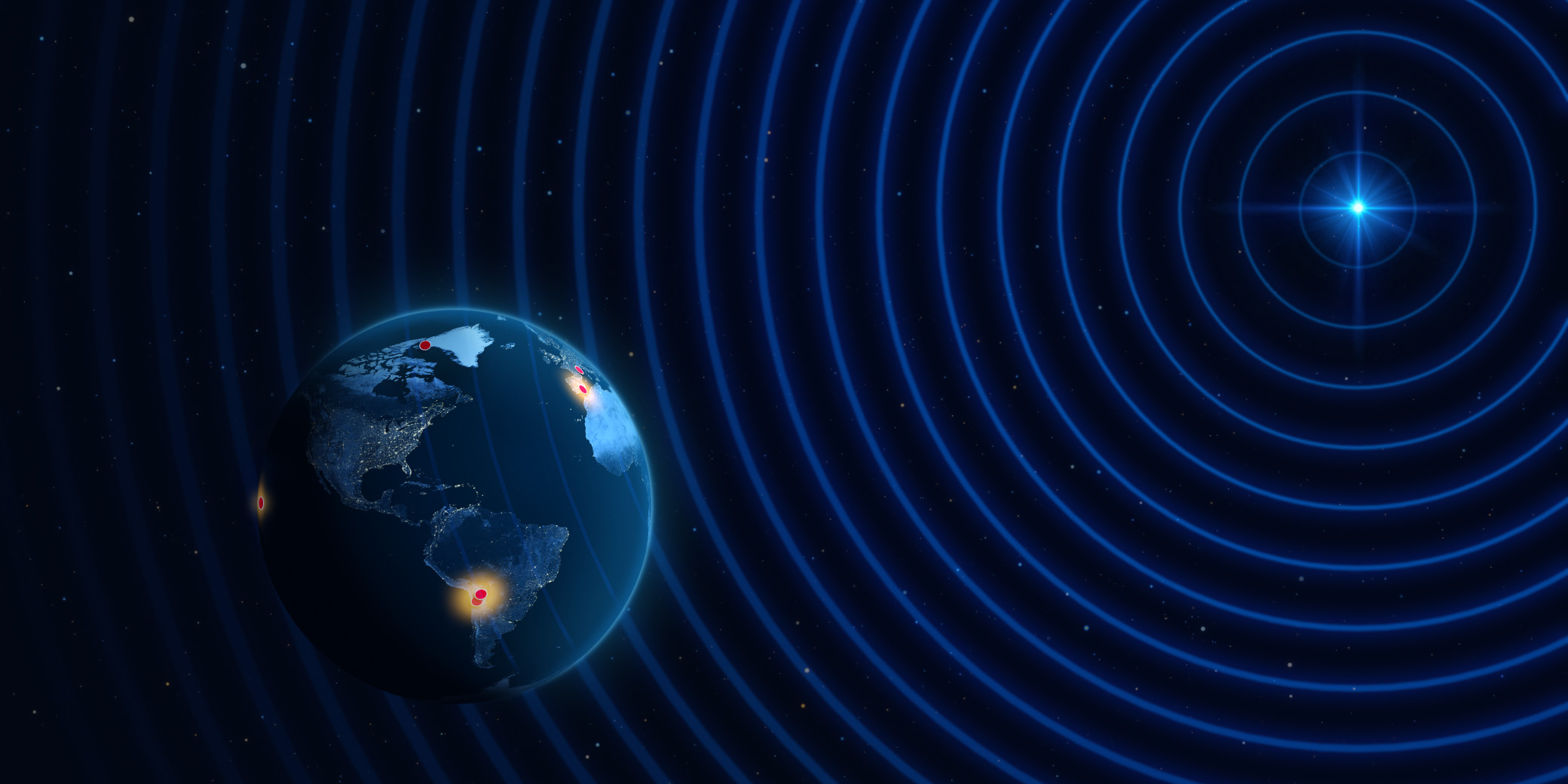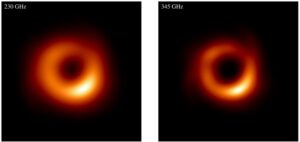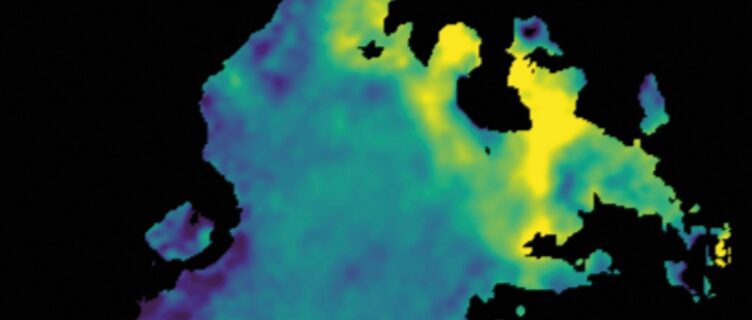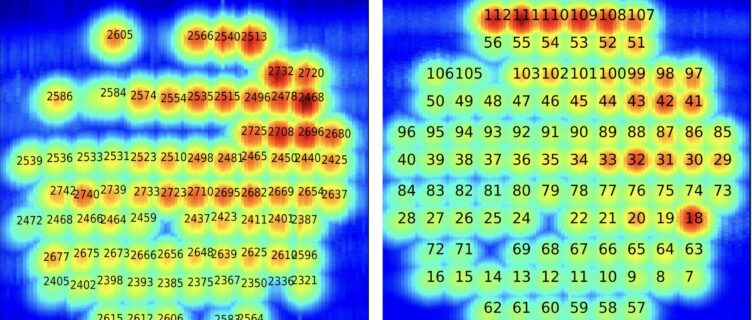The Event Horizon Telescope (EHT) Collaboration, in collaboration with the Atacama Large Millimeter/submillimeter Array (ALMA), has conducted test observations achieving the highest-resolution ever obtained from the surface of the Earth, by detecting light from the centers of distant galaxies at a frequency of around 345 GHz, equivalent to a wavelength of 0.87mm. The Collaboration, which has already imaged supermassive black holes at the hearts of M87 and Sgr A, estimates that with this breakthrough, they will be able to make black hole images 50% more detailed than was possible before and bring the region immediately outside the boundary of these cosmic beasts into sharper focus. The new detections were published today in The Astronomical Journal.
“With the EHT, we saw the first images of black holes by detecting radio waves at the 1.3mm wavelength, but the bright ring we saw, formed by light bending in the black hole’s gravity still looked blurry because we were at the absolute limits of how sharp we could make the images,” said paper co-lead Alexander Raymond, previously a postdoctoral scholar at the Center for Astrophysics | Harvard & Smithsonian (CfA), and now at the Jet Propulsion Laboratory. “At 0.87mm, our images will be sharper and more detailed, which in turn will likely reveal new properties, both those that were previously predicted and maybe some that weren’t.”
The EHT creates a virtual Earth-sized telescope by linking together multiple radio dishes across the globe, using a technique called very-long-baseline interferometry (VLBI). To get higher-resolution images, astronomers have two options: increase the distance between radio dishes or observe at a shorter wavelength. Since the EHT was already the size of our planet, increasing the resolution of ground-based observations required expanding its wavelength range, and that’s what the Collaboration has now done.
The new experiment used two small subarrays of the EHT—made up of ALMA and the Atacama Pathfinder EXperiment (APEX) in Chile, the IRAM 30-meter telescope in Spain, the NOrthern Extended Millimeter Array (NOEMA) in France, the Submillimeter Array (SMA) on Mauna Kea in Hawaiʻi, and the Greenland Telescope—to make measurements with resolution as fine as 19 microarcseconds. At 0.87mm with the full EHT, scientists could see details as fine as 13 microarcseconds, much like observing a bottle cap on the Moon from Earth. This amounts to a 50% increase in resolution over what is currently possible. Importantly, EHT scientists are confident that these improvements will help to refine the study of black holes and unlock their many secrets.
Paper co-lead Sheperd “Shep” Doeleman, an astrophysicist at the CfA and the Founding Director of the EHT said of the major breakthrough, “Consider the burst of extra detail you get going from black and white photos to color. This new ‘color vision’ allows us to tease apart the effects of Einstein’s gravity from the hot gas and magnetic fields that feed the black holes and launch powerful jets that stream over galactic distances.” With this in mind, he added that the Collaboration is excited to reimage M87* and Sgr A* at both 1.3mm and 0.87mm, and move from detecting black hole ‘shadows’ to more precisely measuring their sizes and shapes, which can help to estimate a black hole’s spin and orientation on the sky.
Side-by-side simulated images of M87* show the improvement in clarity and resolution from 230 GHz (1.3mm) to 345 GHz (0.87mm). These improvements are allowing scientists to measure the size and shape of black holes more precisely. Credit: EHT, D. Pesce.
This is the first time the VLBI technique has been successfully used at a wavelength of 0.87mm. While the ability to observe the sky at 0.87mm existed before the new detections, using the VLBI technique at this wavelength has long presented challenges that took time and technological advances to overcome. For example, water vapor in the atmosphere absorbs waves at 0.87mm, much more than at 1.3mm, making it more difficult for radio telescopes to receive signals from black holes at the shorter wavelength. The key was to improve the sensitivity of the EHT, which the researchers did by increasing the bandwidth of the instrumentation and waiting for good weather at all sites.
“With high-bandwidth systems that now process and capture wider swaths of the radio spectrum, we are starting to overcome the basic problem of sensitivity,” said Doris Maier, IRAM. “The time is right, as the new detections prove, to advance to 0.87mm.”
This achievement also provides another stepping stone on the path to creating high-fidelity movies of the event horizon environment surrounding black holes, which will rely on upgrades to the existing global array. The planned next-generation EHT (ngEHT) project will add new antennas to the EHT in optimized geographical locations and enhance existing stations by upgrading them all to work at multiple wavelengths between 3mm and 0.87mm at the same time. As a result of these and other upgrades, the global array is expected to increase the amount of sharp, clear data EHT has for imaging by a factor of 10, enabling scientists to not only produce more detailed and sensitive images, but movies starring these violent cosmic beasts.
More Information
“First Very Long Baseline Interferometry Detections at 870 μm,” A.W. Raymond et al (2024), The Astronomical Journal, DOI: 10.3847/1538-3881/ad5bdb
The EHT Collaboration involves more than 400 researchers from Africa, Asia, Europe, North and South America, with around 270 participating in this paper. The international collaboration aims to capture the most detailed black hole images ever obtained by creating a virtual Earth-sized telescope. Supported by considerable international efforts, the EHT links existing telescopes using novel techniques—creating a fundamentally new instrument with the highest angular resolving power that has yet been achieved.
The EHT consortium consists of 13 stakeholder institutes; the Academia Sinica Institute of Astronomy and Astrophysics, the University of Arizona, the Center for Astrophysics | Harvard & Smithsonian, the University of Chicago, the East Asian Observatory, Goethe University Frankfurt, Institut de Radioastronomie Millimétrique, Large Millimeter Telescope, Max Planck Institute for Radio Astronomy, MIT Haystack Observatory, National Astronomical Observatory of Japan, Perimeter Institute for Theoretical Physics, and Radboud University.
IRAM is an international research organization for millimeter and submillimeter astronomy supported by the CNRS (France), the Max-Planck Gesellschaft (Germany), and the IGN (Spain). The organization operates two world-class research facilities, the IRAM 30-meter telescope in Spain, and NOEMA (Northern Extended Millimeter Array), the largest millimeter interferometer of the northern hemisphere, in the French Alps. IRAM is also a leader in the development of advanced technologies for millimeter astronomy, and has produced most of the 0.87 mm receivers used in these observations.
Media contacts
Michael Bremer, IRAM
Grenoble, France
Tel: +33 476 82 49 81
Email: bremer@iram.fr
Credit background picture: ESO/M. Kornmesser
Our latest updates
Explore all the latest news from our research and technology groups and never miss out on important upcoming events.















